Comparative Programming Languages: AutoSec Programming Language Report
VerifiedAdded on 2023/01/23
|13
|3853
|23
Report
AI Summary
This report provides a comprehensive overview of the AutoSec programming language, designed specifically for e-commerce applications. It delves into the core features of AutoSec, including object orientation, platform independence, simplicity, security (two-tier authentication and encryption), architecture neutrality, portability, robustness, multi-threading, interpretation, and distribution capabilities. The report examines the Just-In-Time (JIT) compilation method chosen for AutoSec, along with a detailed discussion of its memory management system, encompassing the AutoSec memory structure, garbage collection, and the roles of the AutoSec Heap, Stacks, and Program Counter Register. Furthermore, the report outlines the rationale behind key language features such as simplicity, orthogonality and AutoLog feature, providing insights into the design decisions that make AutoSec suitable for web and mobile-based program development within the e-commerce domain. The report also covers features such as robust error handling, multi-threading, and distributed capabilities. The report concludes by emphasizing the benefits of AutoSec's features for simplifying the software development process, enhancing code maintainability, and improving the overall performance of e-commerce applications.

AutoSec Programming Language
Student Name
College
Student Name
College
Paraphrase This Document
Need a fresh take? Get an instant paraphrase of this document with our AI Paraphraser
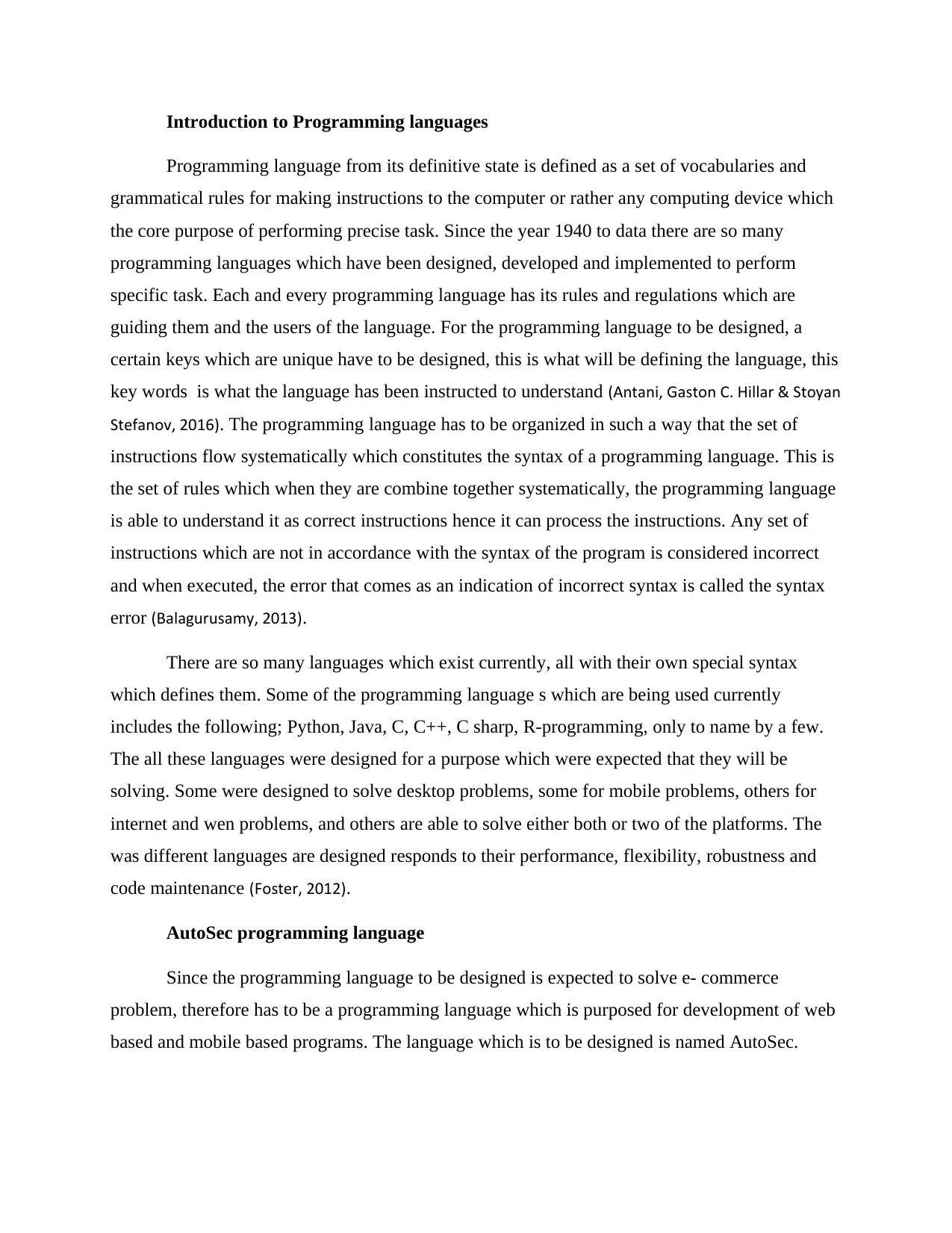
Introduction to Programming languages
Programming language from its definitive state is defined as a set of vocabularies and
grammatical rules for making instructions to the computer or rather any computing device which
the core purpose of performing precise task. Since the year 1940 to data there are so many
programming languages which have been designed, developed and implemented to perform
specific task. Each and every programming language has its rules and regulations which are
guiding them and the users of the language. For the programming language to be designed, a
certain keys which are unique have to be designed, this is what will be defining the language, this
key words is what the language has been instructed to understand (Antani, Gaston C. Hillar & Stoyan
Stefanov, 2016). The programming language has to be organized in such a way that the set of
instructions flow systematically which constitutes the syntax of a programming language. This is
the set of rules which when they are combine together systematically, the programming language
is able to understand it as correct instructions hence it can process the instructions. Any set of
instructions which are not in accordance with the syntax of the program is considered incorrect
and when executed, the error that comes as an indication of incorrect syntax is called the syntax
error (Balagurusamy, 2013).
There are so many languages which exist currently, all with their own special syntax
which defines them. Some of the programming language s which are being used currently
includes the following; Python, Java, C, C++, C sharp, R-programming, only to name by a few.
The all these languages were designed for a purpose which were expected that they will be
solving. Some were designed to solve desktop problems, some for mobile problems, others for
internet and wen problems, and others are able to solve either both or two of the platforms. The
was different languages are designed responds to their performance, flexibility, robustness and
code maintenance (Foster, 2012).
AutoSec programming language
Since the programming language to be designed is expected to solve e- commerce
problem, therefore has to be a programming language which is purposed for development of web
based and mobile based programs. The language which is to be designed is named AutoSec.
Programming language from its definitive state is defined as a set of vocabularies and
grammatical rules for making instructions to the computer or rather any computing device which
the core purpose of performing precise task. Since the year 1940 to data there are so many
programming languages which have been designed, developed and implemented to perform
specific task. Each and every programming language has its rules and regulations which are
guiding them and the users of the language. For the programming language to be designed, a
certain keys which are unique have to be designed, this is what will be defining the language, this
key words is what the language has been instructed to understand (Antani, Gaston C. Hillar & Stoyan
Stefanov, 2016). The programming language has to be organized in such a way that the set of
instructions flow systematically which constitutes the syntax of a programming language. This is
the set of rules which when they are combine together systematically, the programming language
is able to understand it as correct instructions hence it can process the instructions. Any set of
instructions which are not in accordance with the syntax of the program is considered incorrect
and when executed, the error that comes as an indication of incorrect syntax is called the syntax
error (Balagurusamy, 2013).
There are so many languages which exist currently, all with their own special syntax
which defines them. Some of the programming language s which are being used currently
includes the following; Python, Java, C, C++, C sharp, R-programming, only to name by a few.
The all these languages were designed for a purpose which were expected that they will be
solving. Some were designed to solve desktop problems, some for mobile problems, others for
internet and wen problems, and others are able to solve either both or two of the platforms. The
was different languages are designed responds to their performance, flexibility, robustness and
code maintenance (Foster, 2012).
AutoSec programming language
Since the programming language to be designed is expected to solve e- commerce
problem, therefore has to be a programming language which is purposed for development of web
based and mobile based programs. The language which is to be designed is named AutoSec.
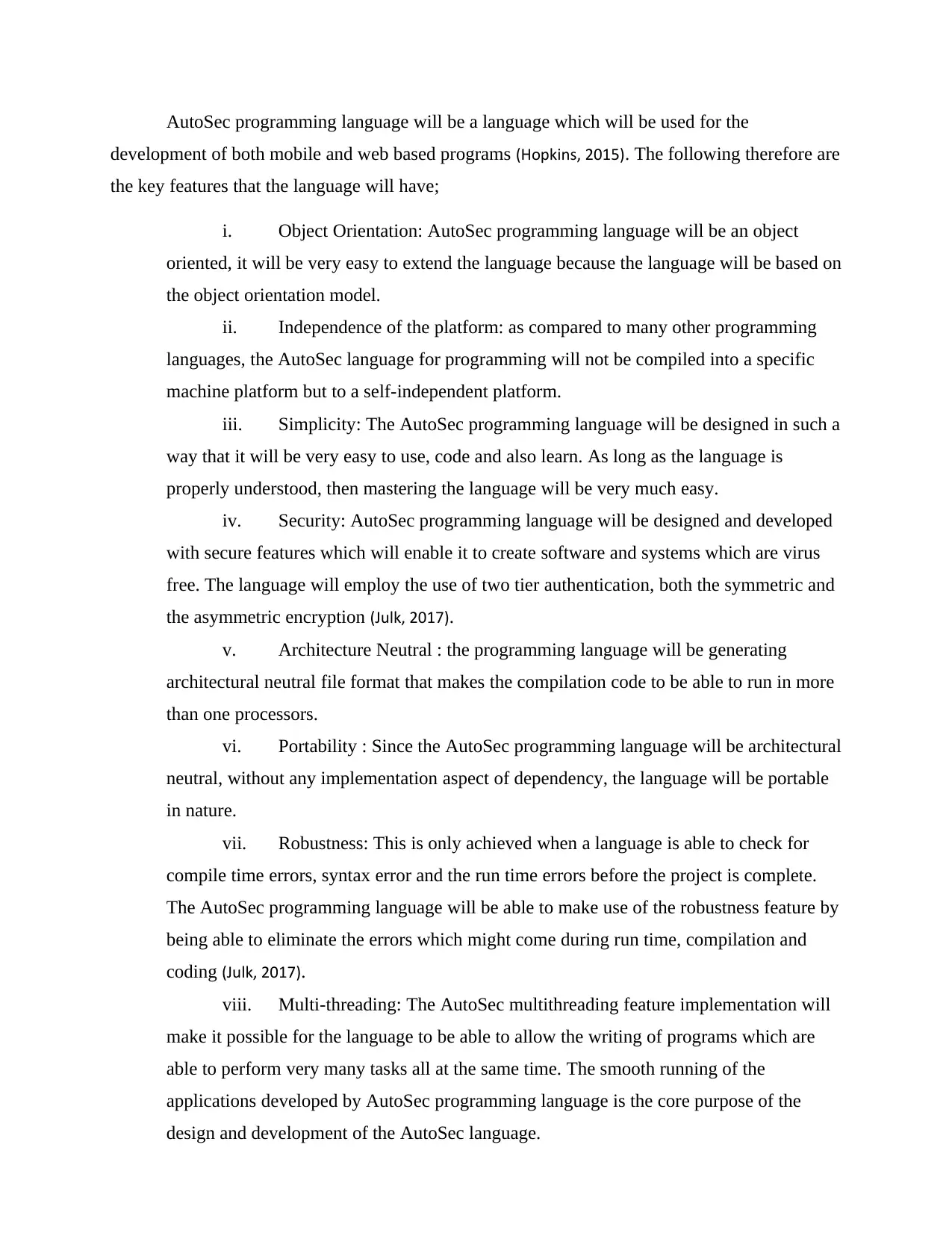
AutoSec programming language will be a language which will be used for the
development of both mobile and web based programs (Hopkins, 2015). The following therefore are
the key features that the language will have;
i. Object Orientation: AutoSec programming language will be an object
oriented, it will be very easy to extend the language because the language will be based on
the object orientation model.
ii. Independence of the platform: as compared to many other programming
languages, the AutoSec language for programming will not be compiled into a specific
machine platform but to a self-independent platform.
iii. Simplicity: The AutoSec programming language will be designed in such a
way that it will be very easy to use, code and also learn. As long as the language is
properly understood, then mastering the language will be very much easy.
iv. Security: AutoSec programming language will be designed and developed
with secure features which will enable it to create software and systems which are virus
free. The language will employ the use of two tier authentication, both the symmetric and
the asymmetric encryption (Julk, 2017).
v. Architecture Neutral : the programming language will be generating
architectural neutral file format that makes the compilation code to be able to run in more
than one processors.
vi. Portability : Since the AutoSec programming language will be architectural
neutral, without any implementation aspect of dependency, the language will be portable
in nature.
vii. Robustness: This is only achieved when a language is able to check for
compile time errors, syntax error and the run time errors before the project is complete.
The AutoSec programming language will be able to make use of the robustness feature by
being able to eliminate the errors which might come during run time, compilation and
coding (Julk, 2017).
viii. Multi-threading: The AutoSec multithreading feature implementation will
make it possible for the language to be able to allow the writing of programs which are
able to perform very many tasks all at the same time. The smooth running of the
applications developed by AutoSec programming language is the core purpose of the
design and development of the AutoSec language.
development of both mobile and web based programs (Hopkins, 2015). The following therefore are
the key features that the language will have;
i. Object Orientation: AutoSec programming language will be an object
oriented, it will be very easy to extend the language because the language will be based on
the object orientation model.
ii. Independence of the platform: as compared to many other programming
languages, the AutoSec language for programming will not be compiled into a specific
machine platform but to a self-independent platform.
iii. Simplicity: The AutoSec programming language will be designed in such a
way that it will be very easy to use, code and also learn. As long as the language is
properly understood, then mastering the language will be very much easy.
iv. Security: AutoSec programming language will be designed and developed
with secure features which will enable it to create software and systems which are virus
free. The language will employ the use of two tier authentication, both the symmetric and
the asymmetric encryption (Julk, 2017).
v. Architecture Neutral : the programming language will be generating
architectural neutral file format that makes the compilation code to be able to run in more
than one processors.
vi. Portability : Since the AutoSec programming language will be architectural
neutral, without any implementation aspect of dependency, the language will be portable
in nature.
vii. Robustness: This is only achieved when a language is able to check for
compile time errors, syntax error and the run time errors before the project is complete.
The AutoSec programming language will be able to make use of the robustness feature by
being able to eliminate the errors which might come during run time, compilation and
coding (Julk, 2017).
viii. Multi-threading: The AutoSec multithreading feature implementation will
make it possible for the language to be able to allow the writing of programs which are
able to perform very many tasks all at the same time. The smooth running of the
applications developed by AutoSec programming language is the core purpose of the
design and development of the AutoSec language.
⊘ This is a preview!⊘
Do you want full access?
Subscribe today to unlock all pages.

Trusted by 1+ million students worldwide
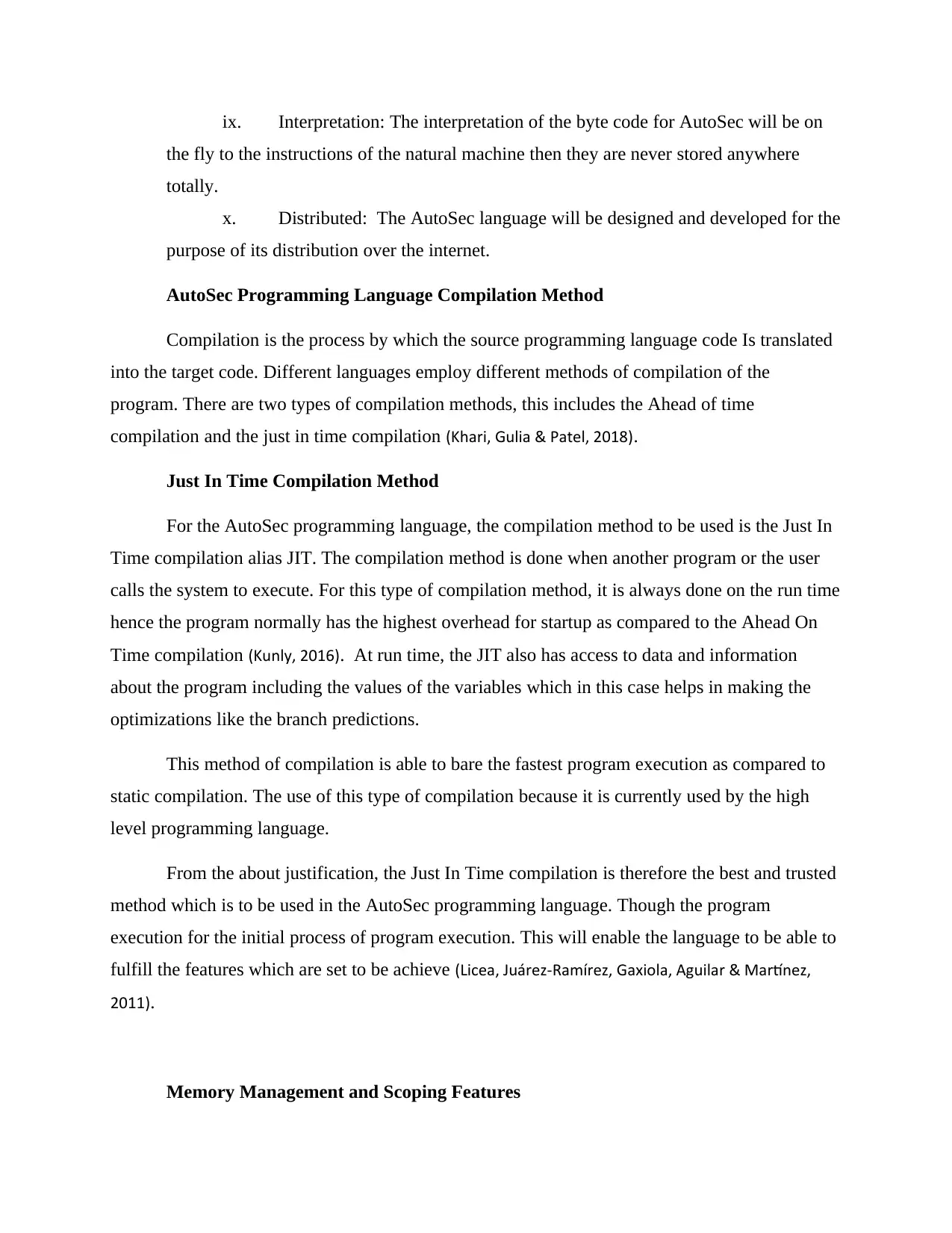
ix. Interpretation: The interpretation of the byte code for AutoSec will be on
the fly to the instructions of the natural machine then they are never stored anywhere
totally.
x. Distributed: The AutoSec language will be designed and developed for the
purpose of its distribution over the internet.
AutoSec Programming Language Compilation Method
Compilation is the process by which the source programming language code Is translated
into the target code. Different languages employ different methods of compilation of the
program. There are two types of compilation methods, this includes the Ahead of time
compilation and the just in time compilation (Khari, Gulia & Patel, 2018).
Just In Time Compilation Method
For the AutoSec programming language, the compilation method to be used is the Just In
Time compilation alias JIT. The compilation method is done when another program or the user
calls the system to execute. For this type of compilation method, it is always done on the run time
hence the program normally has the highest overhead for startup as compared to the Ahead On
Time compilation (Kunly, 2016). At run time, the JIT also has access to data and information
about the program including the values of the variables which in this case helps in making the
optimizations like the branch predictions.
This method of compilation is able to bare the fastest program execution as compared to
static compilation. The use of this type of compilation because it is currently used by the high
level programming language.
From the about justification, the Just In Time compilation is therefore the best and trusted
method which is to be used in the AutoSec programming language. Though the program
execution for the initial process of program execution. This will enable the language to be able to
fulfill the features which are set to be achieve (Licea, Juárez-Ramírez, Gaxiola, Aguilar & Martínez,
2011).
Memory Management and Scoping Features
the fly to the instructions of the natural machine then they are never stored anywhere
totally.
x. Distributed: The AutoSec language will be designed and developed for the
purpose of its distribution over the internet.
AutoSec Programming Language Compilation Method
Compilation is the process by which the source programming language code Is translated
into the target code. Different languages employ different methods of compilation of the
program. There are two types of compilation methods, this includes the Ahead of time
compilation and the just in time compilation (Khari, Gulia & Patel, 2018).
Just In Time Compilation Method
For the AutoSec programming language, the compilation method to be used is the Just In
Time compilation alias JIT. The compilation method is done when another program or the user
calls the system to execute. For this type of compilation method, it is always done on the run time
hence the program normally has the highest overhead for startup as compared to the Ahead On
Time compilation (Kunly, 2016). At run time, the JIT also has access to data and information
about the program including the values of the variables which in this case helps in making the
optimizations like the branch predictions.
This method of compilation is able to bare the fastest program execution as compared to
static compilation. The use of this type of compilation because it is currently used by the high
level programming language.
From the about justification, the Just In Time compilation is therefore the best and trusted
method which is to be used in the AutoSec programming language. Though the program
execution for the initial process of program execution. This will enable the language to be able to
fulfill the features which are set to be achieve (Licea, Juárez-Ramírez, Gaxiola, Aguilar & Martínez,
2011).
Memory Management and Scoping Features
Paraphrase This Document
Need a fresh take? Get an instant paraphrase of this document with our AI Paraphraser
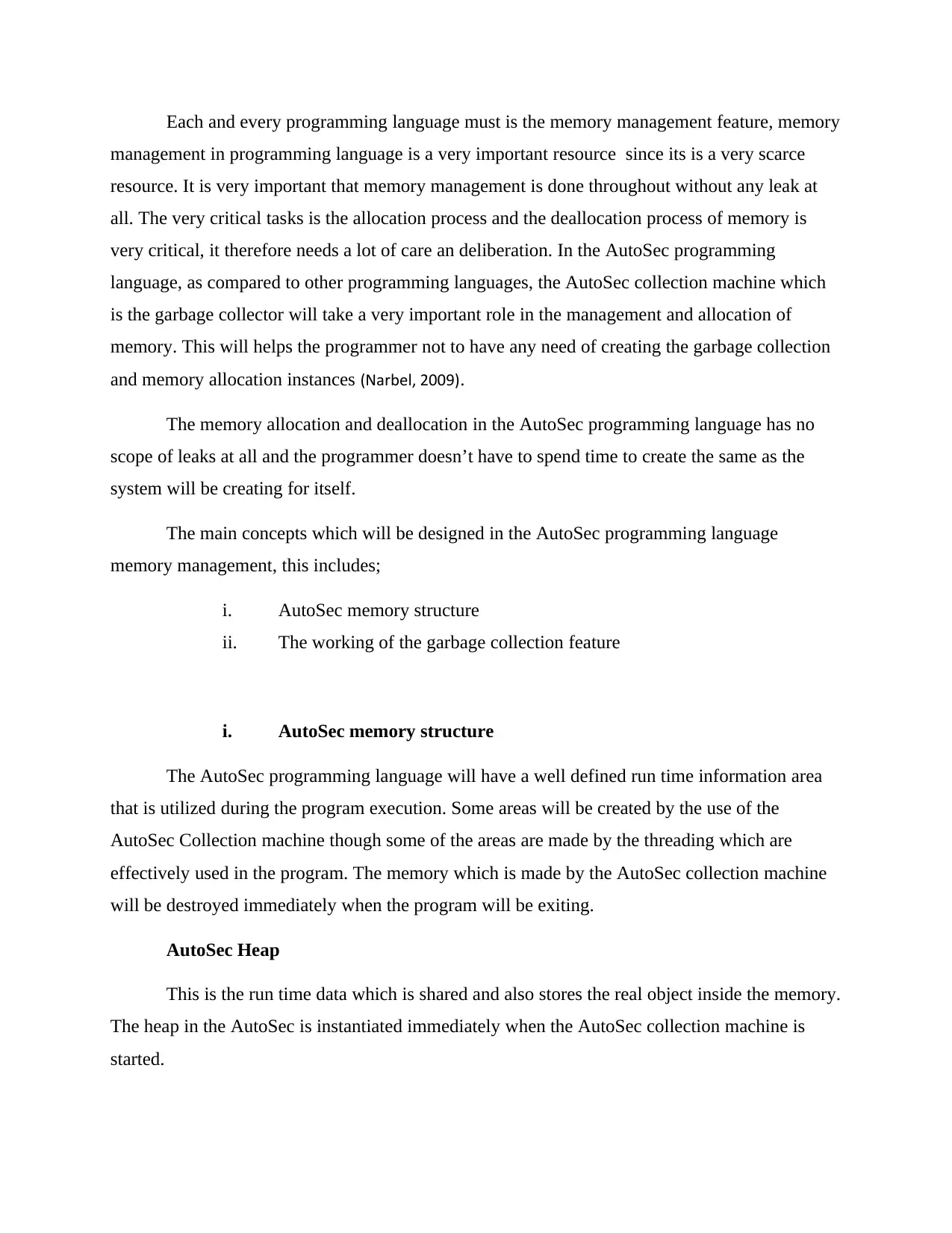
Each and every programming language must is the memory management feature, memory
management in programming language is a very important resource since its is a very scarce
resource. It is very important that memory management is done throughout without any leak at
all. The very critical tasks is the allocation process and the deallocation process of memory is
very critical, it therefore needs a lot of care an deliberation. In the AutoSec programming
language, as compared to other programming languages, the AutoSec collection machine which
is the garbage collector will take a very important role in the management and allocation of
memory. This will helps the programmer not to have any need of creating the garbage collection
and memory allocation instances (Narbel, 2009).
The memory allocation and deallocation in the AutoSec programming language has no
scope of leaks at all and the programmer doesn’t have to spend time to create the same as the
system will be creating for itself.
The main concepts which will be designed in the AutoSec programming language
memory management, this includes;
i. AutoSec memory structure
ii. The working of the garbage collection feature
i. AutoSec memory structure
The AutoSec programming language will have a well defined run time information area
that is utilized during the program execution. Some areas will be created by the use of the
AutoSec Collection machine though some of the areas are made by the threading which are
effectively used in the program. The memory which is made by the AutoSec collection machine
will be destroyed immediately when the program will be exiting.
AutoSec Heap
This is the run time data which is shared and also stores the real object inside the memory.
The heap in the AutoSec is instantiated immediately when the AutoSec collection machine is
started.
management in programming language is a very important resource since its is a very scarce
resource. It is very important that memory management is done throughout without any leak at
all. The very critical tasks is the allocation process and the deallocation process of memory is
very critical, it therefore needs a lot of care an deliberation. In the AutoSec programming
language, as compared to other programming languages, the AutoSec collection machine which
is the garbage collector will take a very important role in the management and allocation of
memory. This will helps the programmer not to have any need of creating the garbage collection
and memory allocation instances (Narbel, 2009).
The memory allocation and deallocation in the AutoSec programming language has no
scope of leaks at all and the programmer doesn’t have to spend time to create the same as the
system will be creating for itself.
The main concepts which will be designed in the AutoSec programming language
memory management, this includes;
i. AutoSec memory structure
ii. The working of the garbage collection feature
i. AutoSec memory structure
The AutoSec programming language will have a well defined run time information area
that is utilized during the program execution. Some areas will be created by the use of the
AutoSec Collection machine though some of the areas are made by the threading which are
effectively used in the program. The memory which is made by the AutoSec collection machine
will be destroyed immediately when the program will be exiting.
AutoSec Heap
This is the run time data which is shared and also stores the real object inside the memory.
The heap in the AutoSec is instantiated immediately when the AutoSec collection machine is
started.
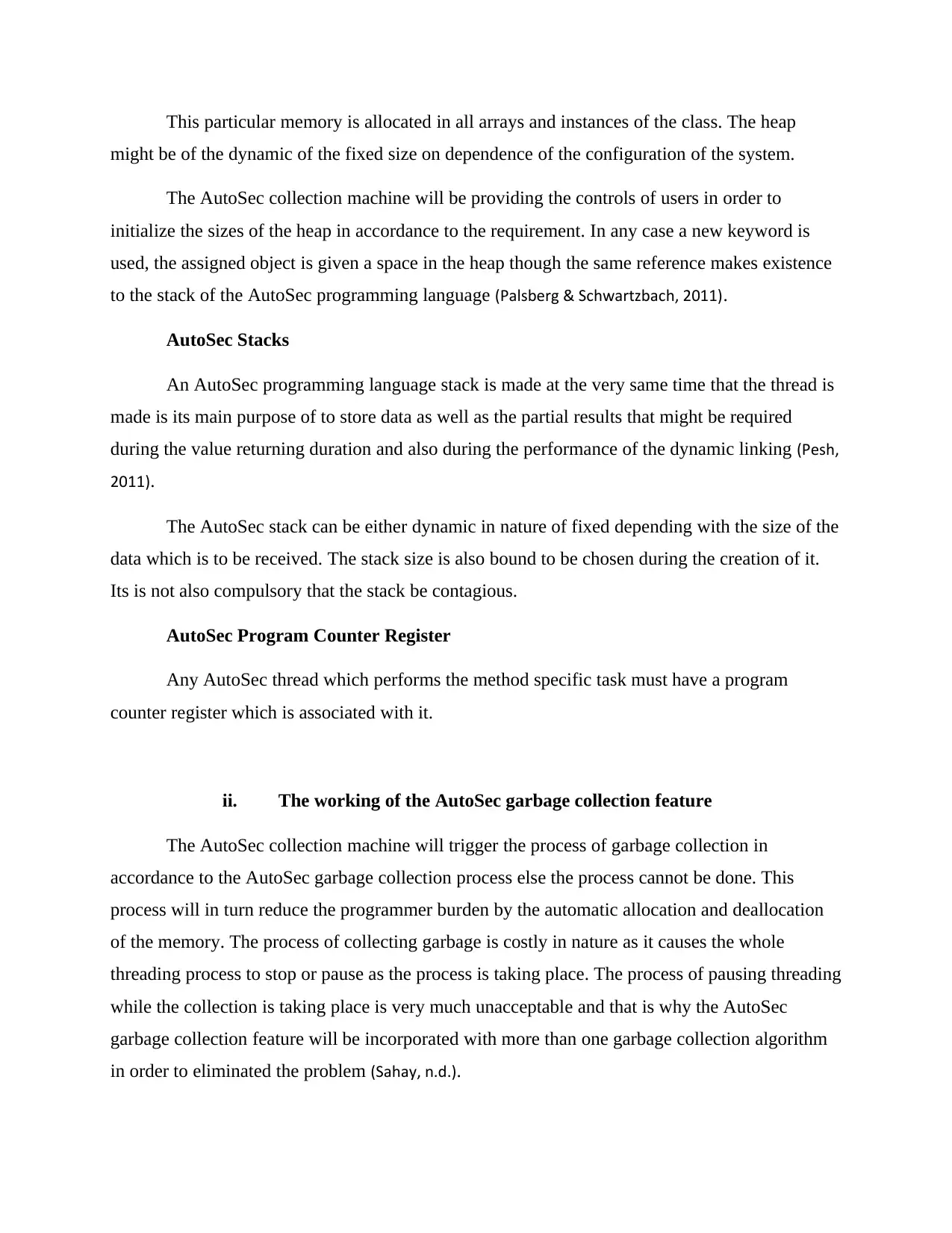
This particular memory is allocated in all arrays and instances of the class. The heap
might be of the dynamic of the fixed size on dependence of the configuration of the system.
The AutoSec collection machine will be providing the controls of users in order to
initialize the sizes of the heap in accordance to the requirement. In any case a new keyword is
used, the assigned object is given a space in the heap though the same reference makes existence
to the stack of the AutoSec programming language (Palsberg & Schwartzbach, 2011).
AutoSec Stacks
An AutoSec programming language stack is made at the very same time that the thread is
made is its main purpose of to store data as well as the partial results that might be required
during the value returning duration and also during the performance of the dynamic linking (Pesh,
2011).
The AutoSec stack can be either dynamic in nature of fixed depending with the size of the
data which is to be received. The stack size is also bound to be chosen during the creation of it.
Its is not also compulsory that the stack be contagious.
AutoSec Program Counter Register
Any AutoSec thread which performs the method specific task must have a program
counter register which is associated with it.
ii. The working of the AutoSec garbage collection feature
The AutoSec collection machine will trigger the process of garbage collection in
accordance to the AutoSec garbage collection process else the process cannot be done. This
process will in turn reduce the programmer burden by the automatic allocation and deallocation
of the memory. The process of collecting garbage is costly in nature as it causes the whole
threading process to stop or pause as the process is taking place. The process of pausing threading
while the collection is taking place is very much unacceptable and that is why the AutoSec
garbage collection feature will be incorporated with more than one garbage collection algorithm
in order to eliminated the problem (Sahay, n.d.).
might be of the dynamic of the fixed size on dependence of the configuration of the system.
The AutoSec collection machine will be providing the controls of users in order to
initialize the sizes of the heap in accordance to the requirement. In any case a new keyword is
used, the assigned object is given a space in the heap though the same reference makes existence
to the stack of the AutoSec programming language (Palsberg & Schwartzbach, 2011).
AutoSec Stacks
An AutoSec programming language stack is made at the very same time that the thread is
made is its main purpose of to store data as well as the partial results that might be required
during the value returning duration and also during the performance of the dynamic linking (Pesh,
2011).
The AutoSec stack can be either dynamic in nature of fixed depending with the size of the
data which is to be received. The stack size is also bound to be chosen during the creation of it.
Its is not also compulsory that the stack be contagious.
AutoSec Program Counter Register
Any AutoSec thread which performs the method specific task must have a program
counter register which is associated with it.
ii. The working of the AutoSec garbage collection feature
The AutoSec collection machine will trigger the process of garbage collection in
accordance to the AutoSec garbage collection process else the process cannot be done. This
process will in turn reduce the programmer burden by the automatic allocation and deallocation
of the memory. The process of collecting garbage is costly in nature as it causes the whole
threading process to stop or pause as the process is taking place. The process of pausing threading
while the collection is taking place is very much unacceptable and that is why the AutoSec
garbage collection feature will be incorporated with more than one garbage collection algorithm
in order to eliminated the problem (Sahay, n.d.).
⊘ This is a preview!⊘
Do you want full access?
Subscribe today to unlock all pages.

Trusted by 1+ million students worldwide
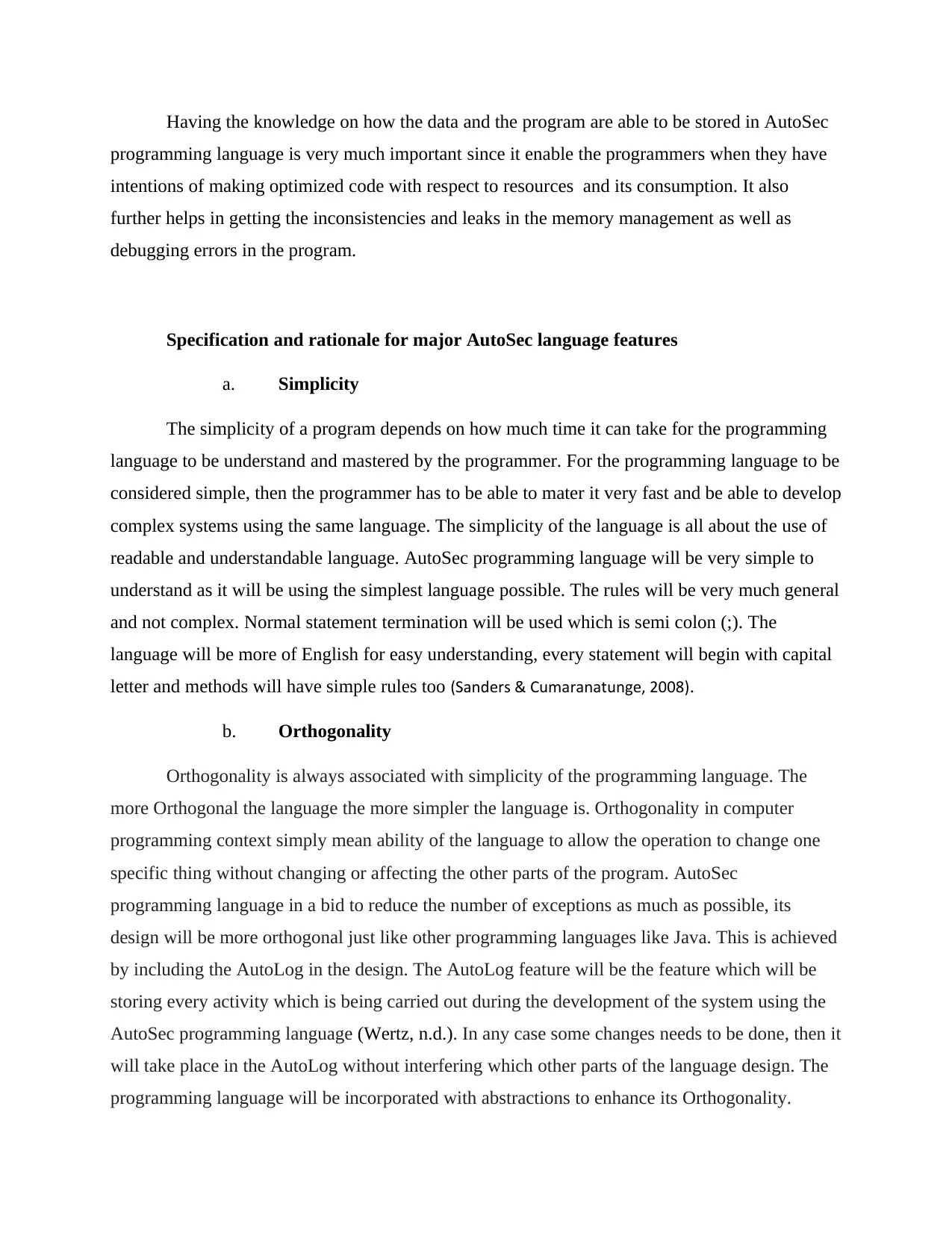
Having the knowledge on how the data and the program are able to be stored in AutoSec
programming language is very much important since it enable the programmers when they have
intentions of making optimized code with respect to resources and its consumption. It also
further helps in getting the inconsistencies and leaks in the memory management as well as
debugging errors in the program.
Specification and rationale for major AutoSec language features
a. Simplicity
The simplicity of a program depends on how much time it can take for the programming
language to be understand and mastered by the programmer. For the programming language to be
considered simple, then the programmer has to be able to mater it very fast and be able to develop
complex systems using the same language. The simplicity of the language is all about the use of
readable and understandable language. AutoSec programming language will be very simple to
understand as it will be using the simplest language possible. The rules will be very much general
and not complex. Normal statement termination will be used which is semi colon (;). The
language will be more of English for easy understanding, every statement will begin with capital
letter and methods will have simple rules too (Sanders & Cumaranatunge, 2008).
b. Orthogonality
Orthogonality is always associated with simplicity of the programming language. The
more Orthogonal the language the more simpler the language is. Orthogonality in computer
programming context simply mean ability of the language to allow the operation to change one
specific thing without changing or affecting the other parts of the program. AutoSec
programming language in a bid to reduce the number of exceptions as much as possible, its
design will be more orthogonal just like other programming languages like Java. This is achieved
by including the AutoLog in the design. The AutoLog feature will be the feature which will be
storing every activity which is being carried out during the development of the system using the
AutoSec programming language (Wertz, n.d.). In any case some changes needs to be done, then it
will take place in the AutoLog without interfering which other parts of the language design. The
programming language will be incorporated with abstractions to enhance its Orthogonality.
programming language is very much important since it enable the programmers when they have
intentions of making optimized code with respect to resources and its consumption. It also
further helps in getting the inconsistencies and leaks in the memory management as well as
debugging errors in the program.
Specification and rationale for major AutoSec language features
a. Simplicity
The simplicity of a program depends on how much time it can take for the programming
language to be understand and mastered by the programmer. For the programming language to be
considered simple, then the programmer has to be able to mater it very fast and be able to develop
complex systems using the same language. The simplicity of the language is all about the use of
readable and understandable language. AutoSec programming language will be very simple to
understand as it will be using the simplest language possible. The rules will be very much general
and not complex. Normal statement termination will be used which is semi colon (;). The
language will be more of English for easy understanding, every statement will begin with capital
letter and methods will have simple rules too (Sanders & Cumaranatunge, 2008).
b. Orthogonality
Orthogonality is always associated with simplicity of the programming language. The
more Orthogonal the language the more simpler the language is. Orthogonality in computer
programming context simply mean ability of the language to allow the operation to change one
specific thing without changing or affecting the other parts of the program. AutoSec
programming language in a bid to reduce the number of exceptions as much as possible, its
design will be more orthogonal just like other programming languages like Java. This is achieved
by including the AutoLog in the design. The AutoLog feature will be the feature which will be
storing every activity which is being carried out during the development of the system using the
AutoSec programming language (Wertz, n.d.). In any case some changes needs to be done, then it
will take place in the AutoLog without interfering which other parts of the language design. The
programming language will be incorporated with abstractions to enhance its Orthogonality.
Paraphrase This Document
Need a fresh take? Get an instant paraphrase of this document with our AI Paraphraser
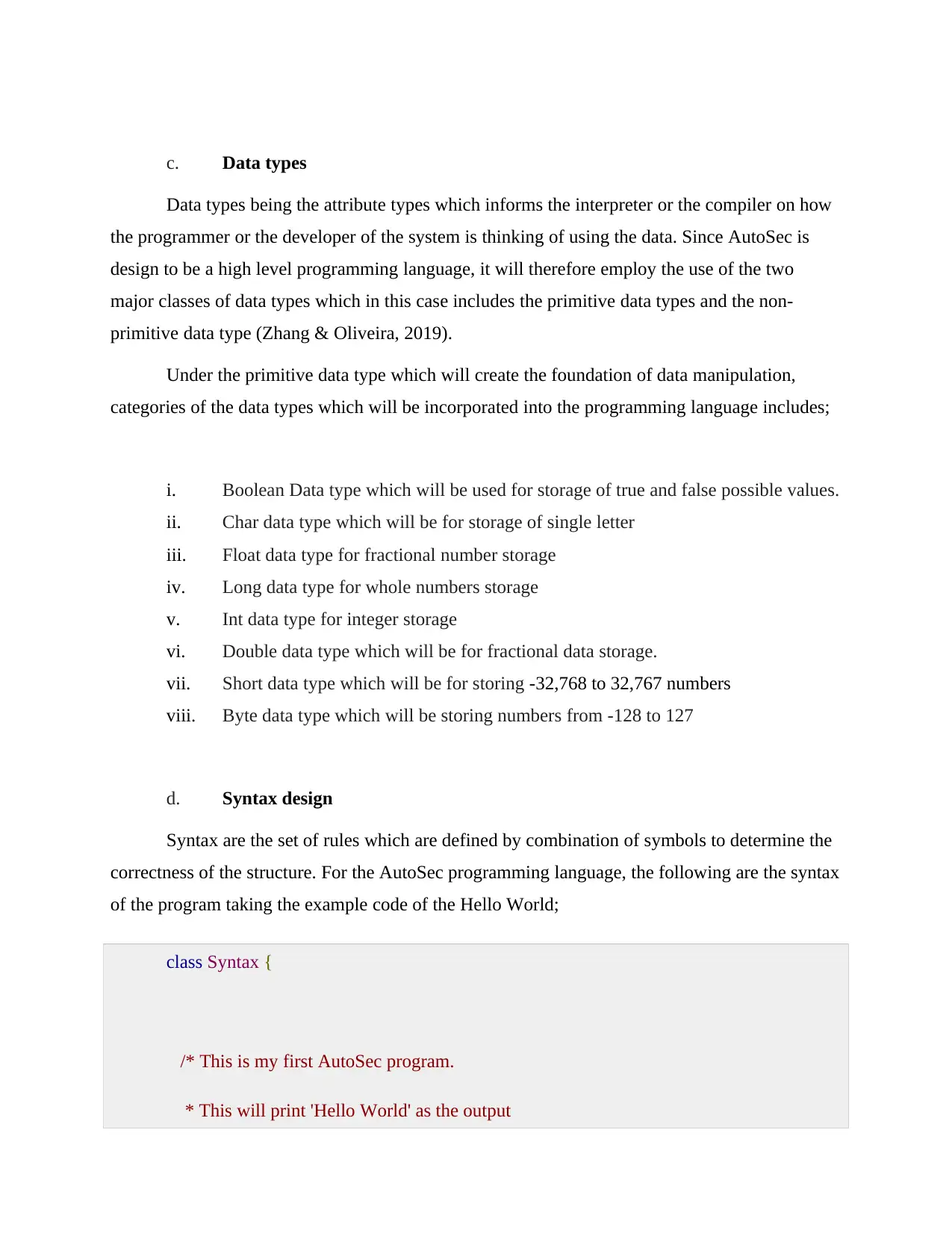
c. Data types
Data types being the attribute types which informs the interpreter or the compiler on how
the programmer or the developer of the system is thinking of using the data. Since AutoSec is
design to be a high level programming language, it will therefore employ the use of the two
major classes of data types which in this case includes the primitive data types and the non-
primitive data type (Zhang & Oliveira, 2019).
Under the primitive data type which will create the foundation of data manipulation,
categories of the data types which will be incorporated into the programming language includes;
i. Boolean Data type which will be used for storage of true and false possible values.
ii. Char data type which will be for storage of single letter
iii. Float data type for fractional number storage
iv. Long data type for whole numbers storage
v. Int data type for integer storage
vi. Double data type which will be for fractional data storage.
vii. Short data type which will be for storing -32,768 to 32,767 numbers
viii. Byte data type which will be storing numbers from -128 to 127
d. Syntax design
Syntax are the set of rules which are defined by combination of symbols to determine the
correctness of the structure. For the AutoSec programming language, the following are the syntax
of the program taking the example code of the Hello World;
class Syntax {
/* This is my first AutoSec program.
* This will print 'Hello World' as the output
Data types being the attribute types which informs the interpreter or the compiler on how
the programmer or the developer of the system is thinking of using the data. Since AutoSec is
design to be a high level programming language, it will therefore employ the use of the two
major classes of data types which in this case includes the primitive data types and the non-
primitive data type (Zhang & Oliveira, 2019).
Under the primitive data type which will create the foundation of data manipulation,
categories of the data types which will be incorporated into the programming language includes;
i. Boolean Data type which will be used for storage of true and false possible values.
ii. Char data type which will be for storage of single letter
iii. Float data type for fractional number storage
iv. Long data type for whole numbers storage
v. Int data type for integer storage
vi. Double data type which will be for fractional data storage.
vii. Short data type which will be for storing -32,768 to 32,767 numbers
viii. Byte data type which will be storing numbers from -128 to 127
d. Syntax design
Syntax are the set of rules which are defined by combination of symbols to determine the
correctness of the structure. For the AutoSec programming language, the following are the syntax
of the program taking the example code of the Hello World;
class Syntax {
/* This is my first AutoSec program.
* This will print 'Hello World' as the output
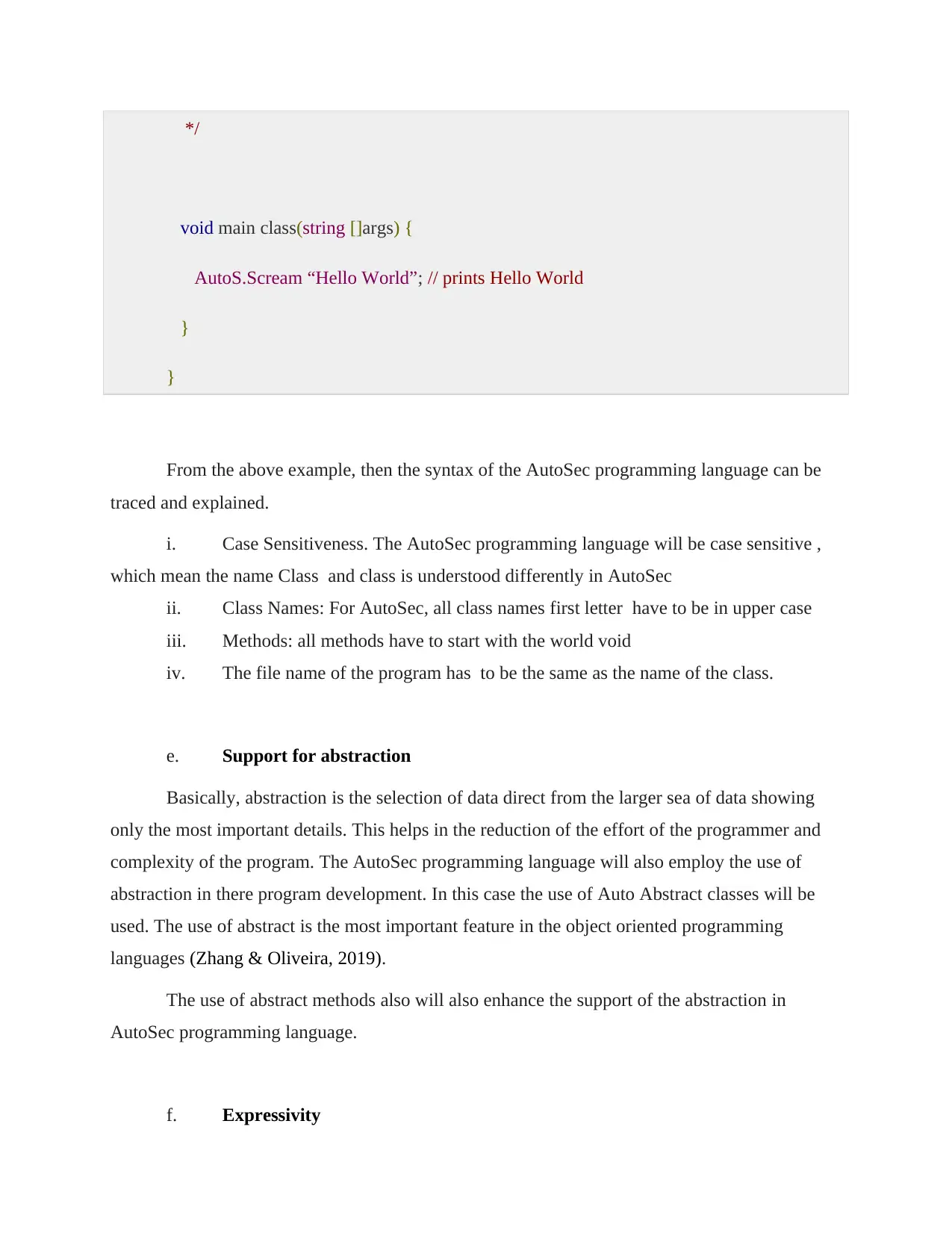
*/
void main class(string []args) {
AutoS.Scream “Hello World”; // prints Hello World
}
}
From the above example, then the syntax of the AutoSec programming language can be
traced and explained.
i. Case Sensitiveness. The AutoSec programming language will be case sensitive ,
which mean the name Class and class is understood differently in AutoSec
ii. Class Names: For AutoSec, all class names first letter have to be in upper case
iii. Methods: all methods have to start with the world void
iv. The file name of the program has to be the same as the name of the class.
e. Support for abstraction
Basically, abstraction is the selection of data direct from the larger sea of data showing
only the most important details. This helps in the reduction of the effort of the programmer and
complexity of the program. The AutoSec programming language will also employ the use of
abstraction in there program development. In this case the use of Auto Abstract classes will be
used. The use of abstract is the most important feature in the object oriented programming
languages (Zhang & Oliveira, 2019).
The use of abstract methods also will also enhance the support of the abstraction in
AutoSec programming language.
f. Expressivity
void main class(string []args) {
AutoS.Scream “Hello World”; // prints Hello World
}
}
From the above example, then the syntax of the AutoSec programming language can be
traced and explained.
i. Case Sensitiveness. The AutoSec programming language will be case sensitive ,
which mean the name Class and class is understood differently in AutoSec
ii. Class Names: For AutoSec, all class names first letter have to be in upper case
iii. Methods: all methods have to start with the world void
iv. The file name of the program has to be the same as the name of the class.
e. Support for abstraction
Basically, abstraction is the selection of data direct from the larger sea of data showing
only the most important details. This helps in the reduction of the effort of the programmer and
complexity of the program. The AutoSec programming language will also employ the use of
abstraction in there program development. In this case the use of Auto Abstract classes will be
used. The use of abstract is the most important feature in the object oriented programming
languages (Zhang & Oliveira, 2019).
The use of abstract methods also will also enhance the support of the abstraction in
AutoSec programming language.
f. Expressivity
⊘ This is a preview!⊘
Do you want full access?
Subscribe today to unlock all pages.

Trusted by 1+ million students worldwide
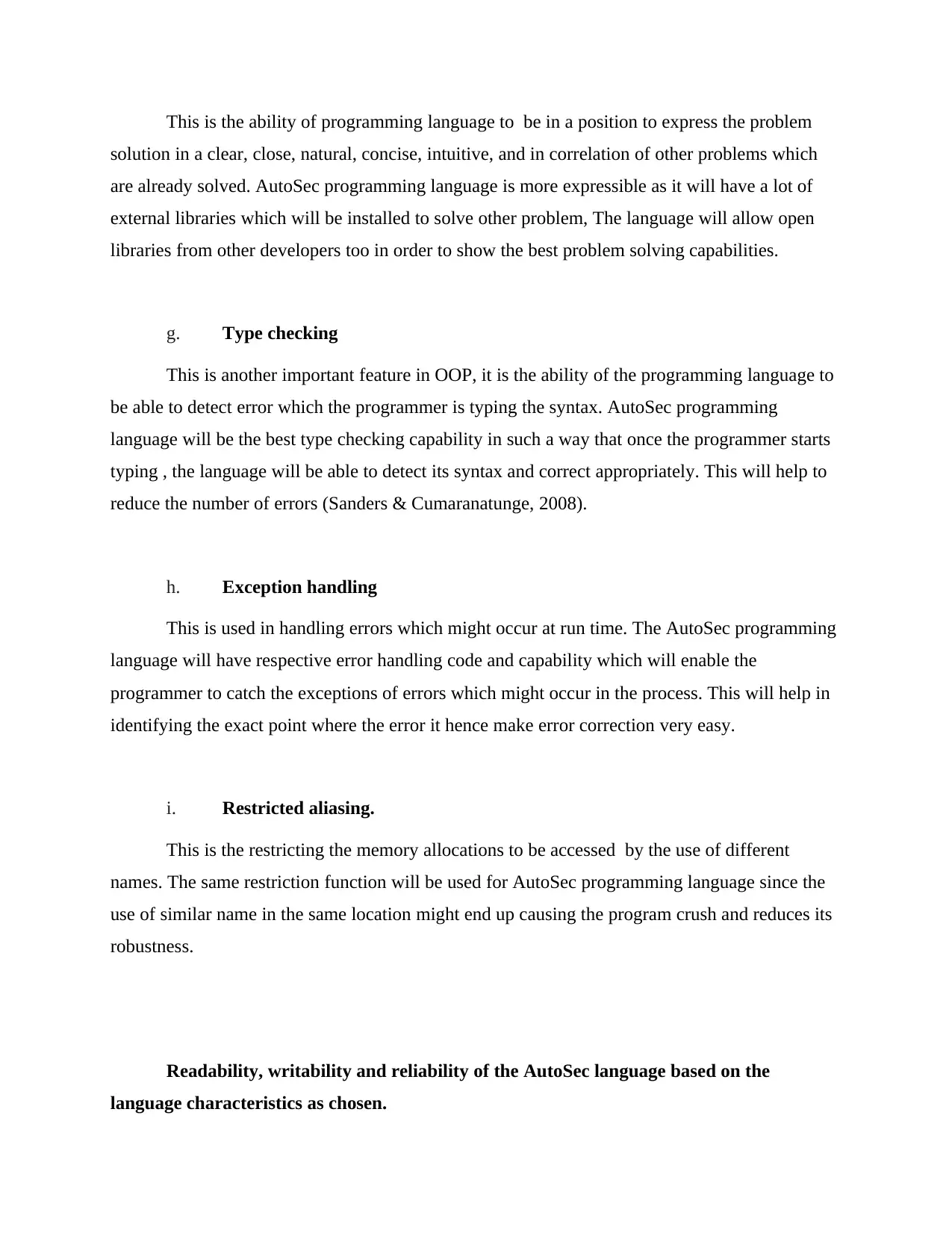
This is the ability of programming language to be in a position to express the problem
solution in a clear, close, natural, concise, intuitive, and in correlation of other problems which
are already solved. AutoSec programming language is more expressible as it will have a lot of
external libraries which will be installed to solve other problem, The language will allow open
libraries from other developers too in order to show the best problem solving capabilities.
g. Type checking
This is another important feature in OOP, it is the ability of the programming language to
be able to detect error which the programmer is typing the syntax. AutoSec programming
language will be the best type checking capability in such a way that once the programmer starts
typing , the language will be able to detect its syntax and correct appropriately. This will help to
reduce the number of errors (Sanders & Cumaranatunge, 2008).
h. Exception handling
This is used in handling errors which might occur at run time. The AutoSec programming
language will have respective error handling code and capability which will enable the
programmer to catch the exceptions of errors which might occur in the process. This will help in
identifying the exact point where the error it hence make error correction very easy.
i. Restricted aliasing.
This is the restricting the memory allocations to be accessed by the use of different
names. The same restriction function will be used for AutoSec programming language since the
use of similar name in the same location might end up causing the program crush and reduces its
robustness.
Readability, writability and reliability of the AutoSec language based on the
language characteristics as chosen.
solution in a clear, close, natural, concise, intuitive, and in correlation of other problems which
are already solved. AutoSec programming language is more expressible as it will have a lot of
external libraries which will be installed to solve other problem, The language will allow open
libraries from other developers too in order to show the best problem solving capabilities.
g. Type checking
This is another important feature in OOP, it is the ability of the programming language to
be able to detect error which the programmer is typing the syntax. AutoSec programming
language will be the best type checking capability in such a way that once the programmer starts
typing , the language will be able to detect its syntax and correct appropriately. This will help to
reduce the number of errors (Sanders & Cumaranatunge, 2008).
h. Exception handling
This is used in handling errors which might occur at run time. The AutoSec programming
language will have respective error handling code and capability which will enable the
programmer to catch the exceptions of errors which might occur in the process. This will help in
identifying the exact point where the error it hence make error correction very easy.
i. Restricted aliasing.
This is the restricting the memory allocations to be accessed by the use of different
names. The same restriction function will be used for AutoSec programming language since the
use of similar name in the same location might end up causing the program crush and reduces its
robustness.
Readability, writability and reliability of the AutoSec language based on the
language characteristics as chosen.
Paraphrase This Document
Need a fresh take? Get an instant paraphrase of this document with our AI Paraphraser
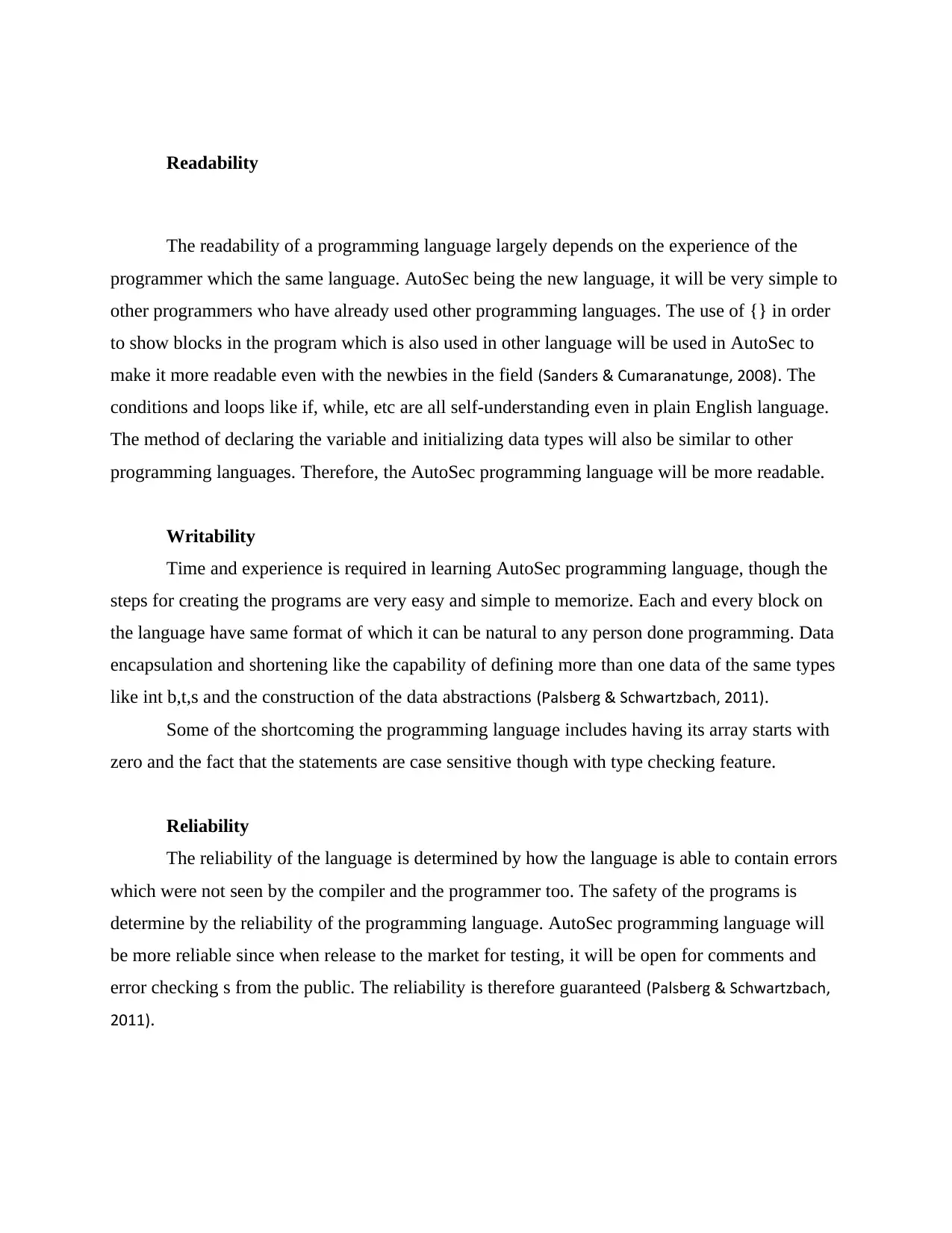
Readability
The readability of a programming language largely depends on the experience of the
programmer which the same language. AutoSec being the new language, it will be very simple to
other programmers who have already used other programming languages. The use of {} in order
to show blocks in the program which is also used in other language will be used in AutoSec to
make it more readable even with the newbies in the field (Sanders & Cumaranatunge, 2008). The
conditions and loops like if, while, etc are all self-understanding even in plain English language.
The method of declaring the variable and initializing data types will also be similar to other
programming languages. Therefore, the AutoSec programming language will be more readable.
Writability
Time and experience is required in learning AutoSec programming language, though the
steps for creating the programs are very easy and simple to memorize. Each and every block on
the language have same format of which it can be natural to any person done programming. Data
encapsulation and shortening like the capability of defining more than one data of the same types
like int b,t,s and the construction of the data abstractions (Palsberg & Schwartzbach, 2011).
Some of the shortcoming the programming language includes having its array starts with
zero and the fact that the statements are case sensitive though with type checking feature.
Reliability
The reliability of the language is determined by how the language is able to contain errors
which were not seen by the compiler and the programmer too. The safety of the programs is
determine by the reliability of the programming language. AutoSec programming language will
be more reliable since when release to the market for testing, it will be open for comments and
error checking s from the public. The reliability is therefore guaranteed (Palsberg & Schwartzbach,
2011).
The readability of a programming language largely depends on the experience of the
programmer which the same language. AutoSec being the new language, it will be very simple to
other programmers who have already used other programming languages. The use of {} in order
to show blocks in the program which is also used in other language will be used in AutoSec to
make it more readable even with the newbies in the field (Sanders & Cumaranatunge, 2008). The
conditions and loops like if, while, etc are all self-understanding even in plain English language.
The method of declaring the variable and initializing data types will also be similar to other
programming languages. Therefore, the AutoSec programming language will be more readable.
Writability
Time and experience is required in learning AutoSec programming language, though the
steps for creating the programs are very easy and simple to memorize. Each and every block on
the language have same format of which it can be natural to any person done programming. Data
encapsulation and shortening like the capability of defining more than one data of the same types
like int b,t,s and the construction of the data abstractions (Palsberg & Schwartzbach, 2011).
Some of the shortcoming the programming language includes having its array starts with
zero and the fact that the statements are case sensitive though with type checking feature.
Reliability
The reliability of the language is determined by how the language is able to contain errors
which were not seen by the compiler and the programmer too. The safety of the programs is
determine by the reliability of the programming language. AutoSec programming language will
be more reliable since when release to the market for testing, it will be open for comments and
error checking s from the public. The reliability is therefore guaranteed (Palsberg & Schwartzbach,
2011).
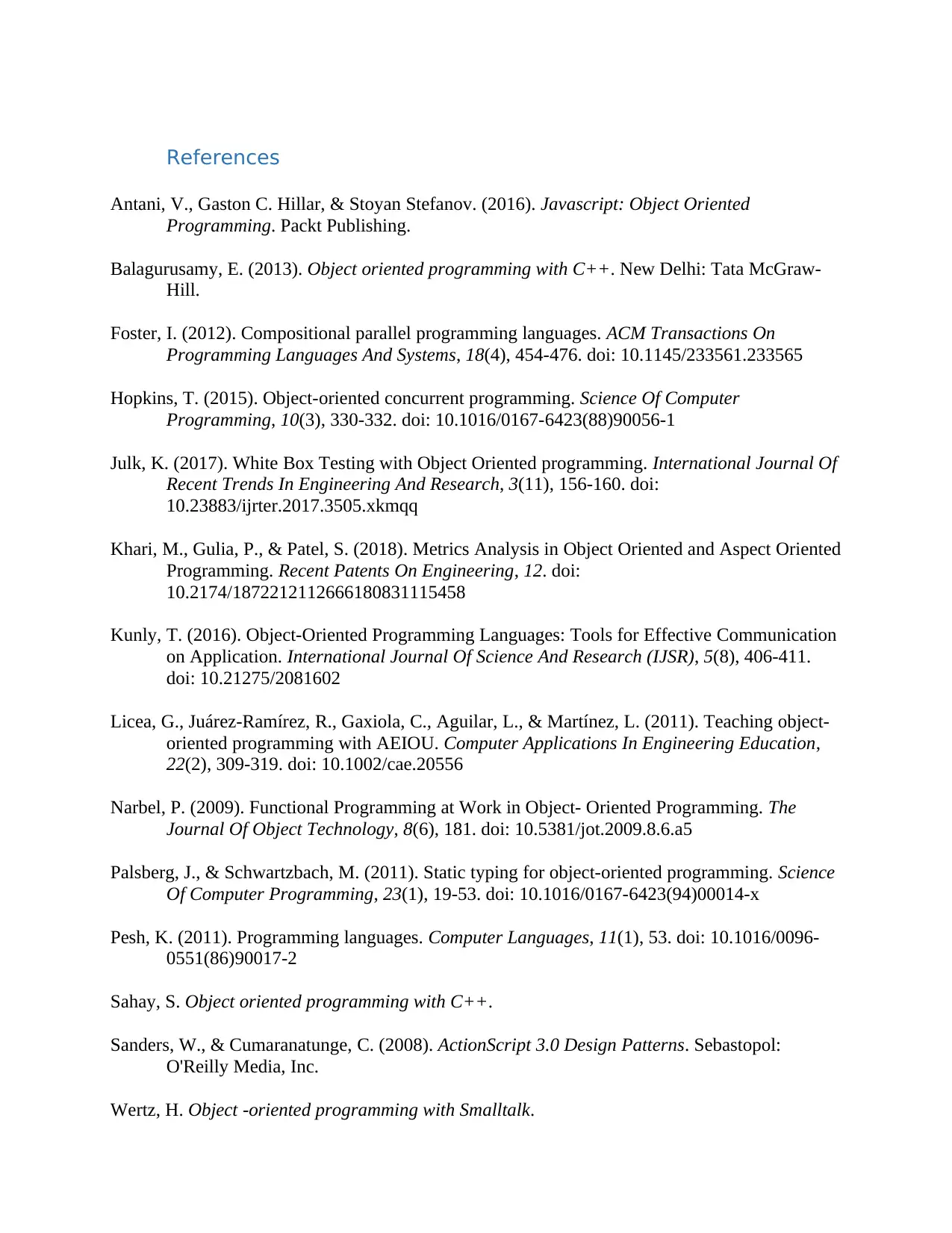
References
Antani, V., Gaston C. Hillar, & Stoyan Stefanov. (2016). Javascript: Object Oriented
Programming. Packt Publishing.
Balagurusamy, E. (2013). Object oriented programming with C++. New Delhi: Tata McGraw-
Hill.
Foster, I. (2012). Compositional parallel programming languages. ACM Transactions On
Programming Languages And Systems, 18(4), 454-476. doi: 10.1145/233561.233565
Hopkins, T. (2015). Object-oriented concurrent programming. Science Of Computer
Programming, 10(3), 330-332. doi: 10.1016/0167-6423(88)90056-1
Julk, K. (2017). White Box Testing with Object Oriented programming. International Journal Of
Recent Trends In Engineering And Research, 3(11), 156-160. doi:
10.23883/ijrter.2017.3505.xkmqq
Khari, M., Gulia, P., & Patel, S. (2018). Metrics Analysis in Object Oriented and Aspect Oriented
Programming. Recent Patents On Engineering, 12. doi:
10.2174/1872212112666180831115458
Kunly, T. (2016). Object-Oriented Programming Languages: Tools for Effective Communication
on Application. International Journal Of Science And Research (IJSR), 5(8), 406-411.
doi: 10.21275/2081602
Licea, G., Juárez-Ramírez, R., Gaxiola, C., Aguilar, L., & Martínez, L. (2011). Teaching object-
oriented programming with AEIOU. Computer Applications In Engineering Education,
22(2), 309-319. doi: 10.1002/cae.20556
Narbel, P. (2009). Functional Programming at Work in Object- Oriented Programming. The
Journal Of Object Technology, 8(6), 181. doi: 10.5381/jot.2009.8.6.a5
Palsberg, J., & Schwartzbach, M. (2011). Static typing for object-oriented programming. Science
Of Computer Programming, 23(1), 19-53. doi: 10.1016/0167-6423(94)00014-x
Pesh, K. (2011). Programming languages. Computer Languages, 11(1), 53. doi: 10.1016/0096-
0551(86)90017-2
Sahay, S. Object oriented programming with C++.
Sanders, W., & Cumaranatunge, C. (2008). ActionScript 3.0 Design Patterns. Sebastopol:
O'Reilly Media, Inc.
Wertz, H. Object -oriented programming with Smalltalk.
Antani, V., Gaston C. Hillar, & Stoyan Stefanov. (2016). Javascript: Object Oriented
Programming. Packt Publishing.
Balagurusamy, E. (2013). Object oriented programming with C++. New Delhi: Tata McGraw-
Hill.
Foster, I. (2012). Compositional parallel programming languages. ACM Transactions On
Programming Languages And Systems, 18(4), 454-476. doi: 10.1145/233561.233565
Hopkins, T. (2015). Object-oriented concurrent programming. Science Of Computer
Programming, 10(3), 330-332. doi: 10.1016/0167-6423(88)90056-1
Julk, K. (2017). White Box Testing with Object Oriented programming. International Journal Of
Recent Trends In Engineering And Research, 3(11), 156-160. doi:
10.23883/ijrter.2017.3505.xkmqq
Khari, M., Gulia, P., & Patel, S. (2018). Metrics Analysis in Object Oriented and Aspect Oriented
Programming. Recent Patents On Engineering, 12. doi:
10.2174/1872212112666180831115458
Kunly, T. (2016). Object-Oriented Programming Languages: Tools for Effective Communication
on Application. International Journal Of Science And Research (IJSR), 5(8), 406-411.
doi: 10.21275/2081602
Licea, G., Juárez-Ramírez, R., Gaxiola, C., Aguilar, L., & Martínez, L. (2011). Teaching object-
oriented programming with AEIOU. Computer Applications In Engineering Education,
22(2), 309-319. doi: 10.1002/cae.20556
Narbel, P. (2009). Functional Programming at Work in Object- Oriented Programming. The
Journal Of Object Technology, 8(6), 181. doi: 10.5381/jot.2009.8.6.a5
Palsberg, J., & Schwartzbach, M. (2011). Static typing for object-oriented programming. Science
Of Computer Programming, 23(1), 19-53. doi: 10.1016/0167-6423(94)00014-x
Pesh, K. (2011). Programming languages. Computer Languages, 11(1), 53. doi: 10.1016/0096-
0551(86)90017-2
Sahay, S. Object oriented programming with C++.
Sanders, W., & Cumaranatunge, C. (2008). ActionScript 3.0 Design Patterns. Sebastopol:
O'Reilly Media, Inc.
Wertz, H. Object -oriented programming with Smalltalk.
⊘ This is a preview!⊘
Do you want full access?
Subscribe today to unlock all pages.

Trusted by 1+ million students worldwide
1 out of 13
Related Documents
Your All-in-One AI-Powered Toolkit for Academic Success.
+13062052269
info@desklib.com
Available 24*7 on WhatsApp / Email
![[object Object]](/_next/static/media/star-bottom.7253800d.svg)
Unlock your academic potential
Copyright © 2020–2025 A2Z Services. All Rights Reserved. Developed and managed by ZUCOL.





